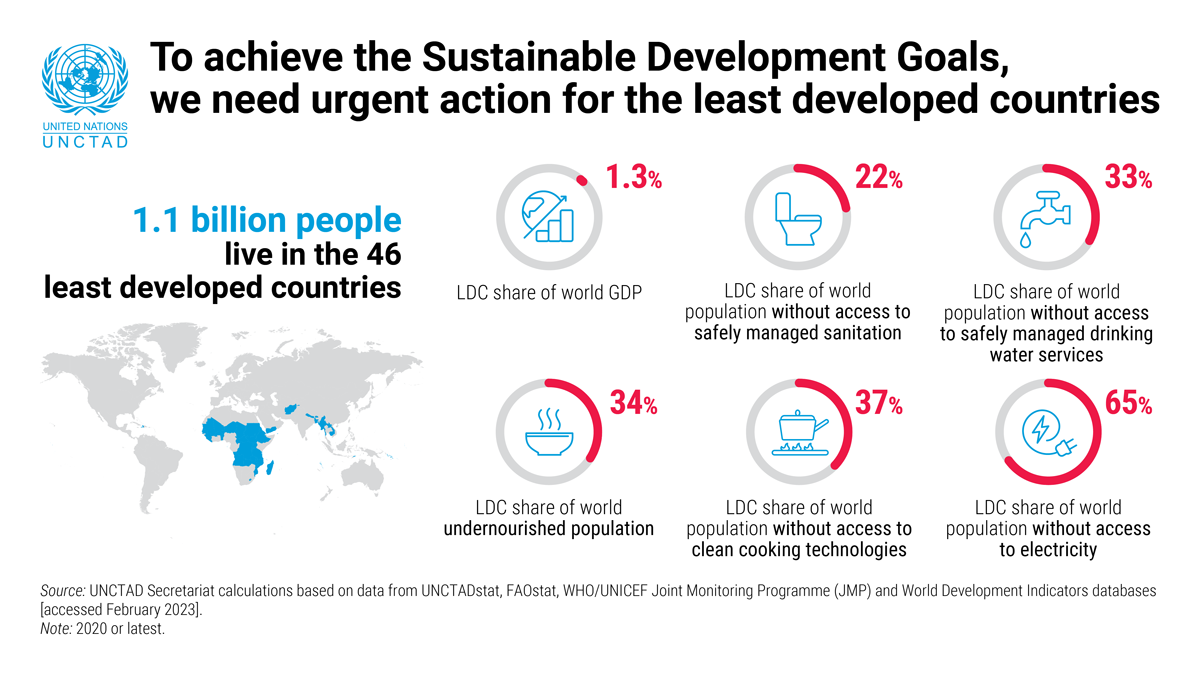Long-standing infrastructure gaps, structural socioeconomic challenges and enormous development needs continue to undermine the resilience of these countries.

The second part of the fifth UN Conference on the Least Developed Countries (LDCs) taking place in Doha, Qatar from 5 to 9 March comes at a critical moment.
It comes when the 46 LDCs are sharply hit by multiple crises: geopolitical fragmentation, a pervasive climate crisis, high inflation, rising debt, poverty and hunger.
LDCs are at a critical juncture and risk falling further behind
LDCs are characterized by limited productive capacities and multiple structural constraints to tackle today’s polycrisis that can have disproportionately damaging effects on their economies. They’re the countries least prepared to tackle these crises.
Even before the pandemic, many LDCs were off-track in achieving the Sustainable Development Goals (SDGs).
The harsh reality is that, with 1.1 billion people, or 14% of world population, LDCs account for more than half of world’s extremely poor (those living on less than $1.9 a day), yet their economies account for only 1.3% of the world’s total.
Moreover, hunger remains alarmingly high. In 2021, an estimated 768 million people globally were undernourished, of whom 34% were from LDCs.
Restrictive trade measures, sustained shortages and high prices could further worsen food availability and access in LDCs, where food insecurity is already rampant (more than 50%), with the prevalence being higher among women than men.
Four LDCs faced famine-like conditions in 2021, due to a confluence of armed conflict, economic decline and weather extremes.
Sustainable management of water resources and access to safe water and sanitation is another hurdle LDCs face. Despite encouraging progress in recent decades, in 2020, 665 million people in LDCs lacked access to safe drinking water services (about one third of the global average) and 782 million lacked access to sanitation (about 22% of the global average).
LDCs also face challenges in relation to access to affordable, reliable, sustainable and modern energy. They accounted for one third of the world’s population without access to clean cooking, and for two thirds of the people without access to electricity during the same period.
Furthermore, LDCs have large domestic inequalities in access to energy, including along the rural–urban divide. In 2020, on average, 78% of the urban population in LDCs had electricity access, compared with only 44% of rural populations.
Need to transform LDC economies
Without a structural transformation that prioritizes economic diversification and addresses institutional and capacity constraints, LDCs will continue to remain vulnerable to existing and future external shocks, particularly climate change.
The scale of LDC infrastructure gaps is a major hindrance to their structural transformation and human development, and undermines their overall resilience to climate change, weather extremes and related risks.
These gaps deserve primary consideration in the pursuit of any realistic approach to regaining momentum towards the SDGs and a “just transition” to a low-carbon economy.
The huge infrastructure gaps warrant a systemic and long-term expansionary approach to infrastructure development and the building of productive capacities. This involves improved coordination between public and private investment, including through international cooperation. Women, youth and vulnerable groups should be at the centre of these efforts.
Downloads:
- The Least Developed Countries Report 2022: The low-carbon transition and its daunting implications for structural transformation.
- The Least Developed Countries Report 2021: The least developed countries in the post-COVID world: Learning from 50 years of experience.
- UNCTAD Productive Capacities Index: Methodological Approach and Results.
- The State of Food Security and Nutrition in the World 2022. Repurposing food and agricultural policies to make healthy diets more affordable.


